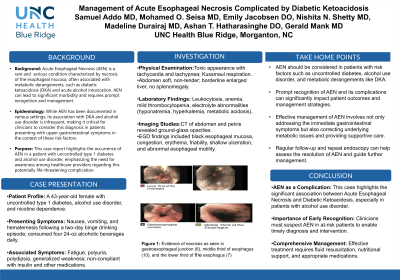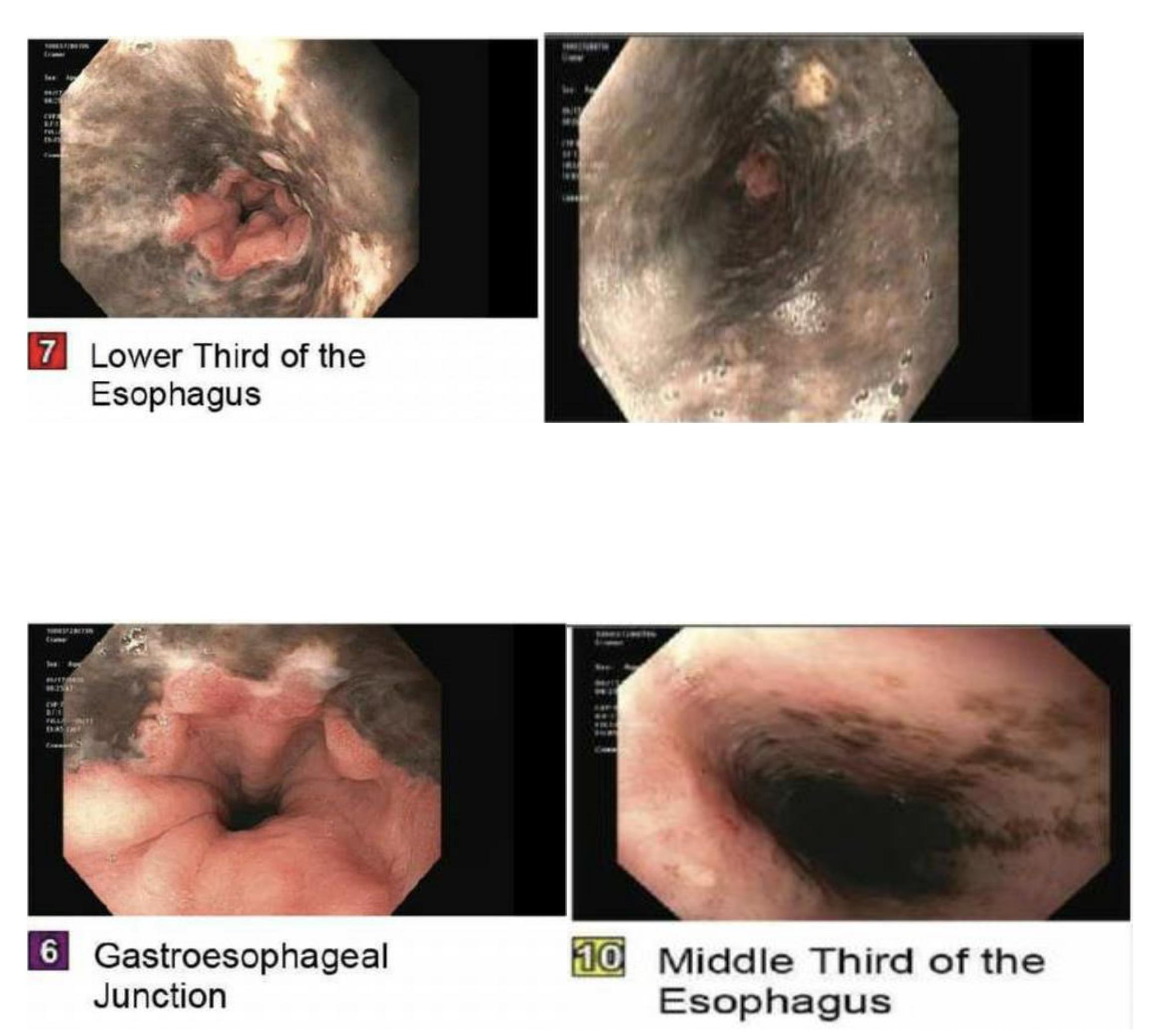Monday Poster Session
Category: Esophagus
P2271 - Management of Acute Esophageal Necrosis Complicated by Diabetic Ketoacidosis
Monday, October 28, 2024
10:30 AM - 4:00 PM ET
Location: Exhibit Hall E

Has Audio

Samuel Addo, MD
UNC Health Blue Ridge
Morganton, NC
Presenting Author(s)
Samuel Addo, MD, Mohamed O. Seisa, MD, Emily Jacobsen, BS, DO, Nishita N. Shetty, MD, Madeline Durairaj, MD, Ashan T. Hatharasinghe, DO, Gerald Mank, MD
UNC Health Blue Ridge, Morganton, NC
Introduction: Acute esophageal necrosis (AEN), also known as Gurvits syndrome, is a rare but potentially life-threatening condition with a very high mortality rate characterized by diffuse black discoloration of the esophageal mucosa. While typically associated with older males with multiple comorbidities, its occurrence in young female is rare. We present a uniques case of a 43-year-old female with uncontrolled type 1 diabetes who developed AEN and DKA following a binge drinking episode.
Case Description/Methods: A 43-year-old female, with a history of uncontrolled type 1 diabetes, alcohol abuse disorder, nicotine dependance presented to the emergency with compliants of nausea, vomiting, and hematemesis following a two-day binge drinking episode. She admitted to consuming four 24 oz alcoholic beverages daily and experiencing associated symptoms of fatigue, polyuria, polydipsia, and generalized weakness.She was non-complaint with insulin and other medications during this period. On admission, she appeared toxic with tachycardia and tachypneic with Kussmaul respiration. Physical examination revealed diffuse rhonchi and epigastric tenderness. Laboratory investigations revealed leukocytosis, anemia, mild thrombocytopenia, and significant electrolyte abnormalities, including hyponatremia, hyperkalemia, and metabolic acidosis. CT abdomen and pelvis showed ground-glass opacities, while esophagogastroduodenoscopy (EGD) demonstrated features consistent with AEN, including black esophageal mucosa, congestion, erythema, friability, shallow ulceration, and abnormal esophageal motility. Biopsy showed acutely inflamed necrotic debris with candida. Management involved critical care admission, fluid resuscitation, strict NPO status for 72 hours, TPN, and gradual advancement of diet. She was treated with intravenous pantoprazole, sucralfate, and fluconazole for 14 days. At six weeks follow up, repeat endoscopy revealed resolution of the AEN and associated inflammation
Discussion: The association between AEN and DKA is rare and likely multifactorial, involving factors such as severe dehydration, metabolic acidosis, and compromised mucosal perfusion. While DKA management includes aggressive fluid resuscitation with insulin, AEN management requires additional measures such as proton pump inhibitors, sucralfate, and nutritional support. This case highlights the significance of recognizing AEN as a potential complication of DKA, particularly in patients with predisposing factors such as alcohol abuse and poor glycemic control.

Disclosures:
Samuel Addo, MD, Mohamed O. Seisa, MD, Emily Jacobsen, BS, DO, Nishita N. Shetty, MD, Madeline Durairaj, MD, Ashan T. Hatharasinghe, DO, Gerald Mank, MD. P2271 - Management of Acute Esophageal Necrosis Complicated by Diabetic Ketoacidosis, ACG 2024 Annual Scientific Meeting Abstracts. Philadelphia, PA: American College of Gastroenterology.
UNC Health Blue Ridge, Morganton, NC
Introduction: Acute esophageal necrosis (AEN), also known as Gurvits syndrome, is a rare but potentially life-threatening condition with a very high mortality rate characterized by diffuse black discoloration of the esophageal mucosa. While typically associated with older males with multiple comorbidities, its occurrence in young female is rare. We present a uniques case of a 43-year-old female with uncontrolled type 1 diabetes who developed AEN and DKA following a binge drinking episode.
Case Description/Methods: A 43-year-old female, with a history of uncontrolled type 1 diabetes, alcohol abuse disorder, nicotine dependance presented to the emergency with compliants of nausea, vomiting, and hematemesis following a two-day binge drinking episode. She admitted to consuming four 24 oz alcoholic beverages daily and experiencing associated symptoms of fatigue, polyuria, polydipsia, and generalized weakness.She was non-complaint with insulin and other medications during this period. On admission, she appeared toxic with tachycardia and tachypneic with Kussmaul respiration. Physical examination revealed diffuse rhonchi and epigastric tenderness. Laboratory investigations revealed leukocytosis, anemia, mild thrombocytopenia, and significant electrolyte abnormalities, including hyponatremia, hyperkalemia, and metabolic acidosis. CT abdomen and pelvis showed ground-glass opacities, while esophagogastroduodenoscopy (EGD) demonstrated features consistent with AEN, including black esophageal mucosa, congestion, erythema, friability, shallow ulceration, and abnormal esophageal motility. Biopsy showed acutely inflamed necrotic debris with candida. Management involved critical care admission, fluid resuscitation, strict NPO status for 72 hours, TPN, and gradual advancement of diet. She was treated with intravenous pantoprazole, sucralfate, and fluconazole for 14 days. At six weeks follow up, repeat endoscopy revealed resolution of the AEN and associated inflammation
Discussion: The association between AEN and DKA is rare and likely multifactorial, involving factors such as severe dehydration, metabolic acidosis, and compromised mucosal perfusion. While DKA management includes aggressive fluid resuscitation with insulin, AEN management requires additional measures such as proton pump inhibitors, sucralfate, and nutritional support. This case highlights the significance of recognizing AEN as a potential complication of DKA, particularly in patients with predisposing factors such as alcohol abuse and poor glycemic control.

Figure: EGD finding of black esophageal mucosa, congestion, erythema, friability, shallow ulceration, and abnormal esophageal motility
Disclosures:
Samuel Addo indicated no relevant financial relationships.
Mohamed Seisa indicated no relevant financial relationships.
Emily Jacobsen indicated no relevant financial relationships.
Nishita Shetty indicated no relevant financial relationships.
Madeline Durairaj indicated no relevant financial relationships.
Ashan Hatharasinghe indicated no relevant financial relationships.
Gerald Mank indicated no relevant financial relationships.
Samuel Addo, MD, Mohamed O. Seisa, MD, Emily Jacobsen, BS, DO, Nishita N. Shetty, MD, Madeline Durairaj, MD, Ashan T. Hatharasinghe, DO, Gerald Mank, MD. P2271 - Management of Acute Esophageal Necrosis Complicated by Diabetic Ketoacidosis, ACG 2024 Annual Scientific Meeting Abstracts. Philadelphia, PA: American College of Gastroenterology.
